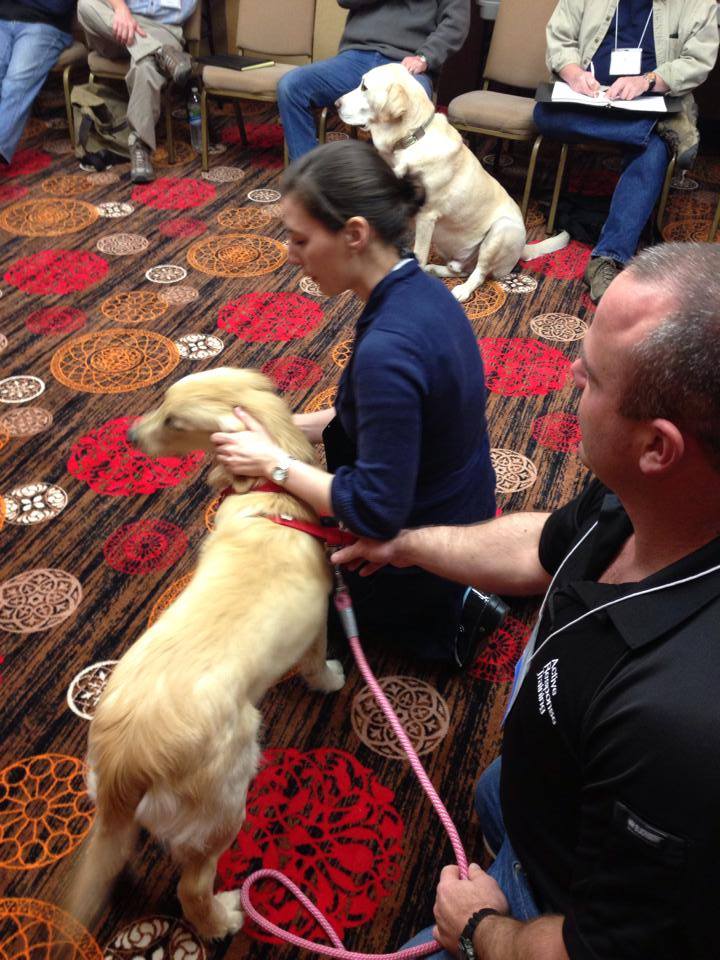Last weekend I had the honor of assisting Dr. Lauren Pugliese as she presented her class on pet first aid at the Rangemaster Tactical Conference.
Dr. Lauren is a former human EMT and is currently practicing as a board-certified small animal veterinary surgeon at a large veterinary specialty hospital.
Dr. Lauren has written an article to accompany her classes. The article below covers some of the basics of pet first aid and provides a list of equipment for stocking a pet first aid kit. Lauren will be expanding on these ideas in future articles as well.
Without further ado, I present the following article written by Lauren Pugliese, DVM….
-Greg
This past weekend I had the unique experience to teach at the Rangemaster Tactical Conference. Admittedly, I sort of fell into this because of my lack of ability to say “no” very well. However, I am glad I didn’t decline this invitation because it was a fantastic experience. While I felt somewhat out of place, most attendees felt I covered a gap in their general emergency preparedness plan by addressing how to handle emergencies for animals.
The course I taught was aimed for the basic pet owner on how to prepare for an emergency and handle small medical issues at home. For me, this focused on identifying potential problems, translating their human medical skills into practical veterinary skills, and advocating for family companion animals in emergency situations.
There are many great resources available on the internet that helped me compile this information, particularly the FEMA website, and Greg Ellifritz was invaluable for helping me make a realistic plan and actually understanding what “tactical medicine” involved. Most veterinarians are accustomed to working in less than perfect conditions and are adept at improvising new ways to wrangle the angry cat or befriend the shy dog. It was my turn to get to share some of this with the conference attendees who were interested in how to better care for their furry family members.
One of the disappointing things I discovered while preparing for my classes was the poor quality of the commercially available pet first aid kits. I put together a list of materials that I would want at home for my pets if I only had basic first aid knowledge. You can find the list below. It is certainly not an all-inclusive list, and depending on your pet and your knowledge base, you may want to modify the contents. I have made some notes on the list with suggestions about specific types of products but any similar item would work and I am not endorsing any specific item. Well, except Vet wrap. Vet wrap is one of the most amazing materials ever invented and is only closely rivaled by duct tape in its versatility.
There are commercially available pet first aid kits sold through various outlets, but I would still consider putting your own together based on what you are comfortable using. Many people may find performing medical treatments to their animals uncomfortable or upsetting. My suggestion is to have basic items and know how to use them well. Store them in a well-marked, easily identifiable bag, and the contents should be stored in waterproof bags.
A good, accessible resource is the American Red Cross Pet First Aid app. It includes basic instructions with diagrams on how to perform first aid maneuvers and has a way to store important medical information for your pet.
These are just some suggestions to get you started. I wish you and your furry family members all the safety there is to have and applaud you in considering their well-being in your planning.
Items to Include in a Pet First Aid Kit:
1. Leash
a. It is important to be able to catch, restrain, and control your dog. Slip leashes are great for this. You can also use an extra leash as available ties, a muzzle, or in a really tight pinch, a tourniquet.
b. Slip leash – Any kind that has a loop you can slip or tighten and expand easily
2. Tie gauze- This can be a triangle bandage, an extra leash, the cling from the bandage, or even a pair of pantyhose
3. Ice pack
4. Scissors- Preferably safety bandage scissors
5. Muzzle
6. Bandage materials
a. Cast padding either 3” or 4” width
b. Cling Wrap either 3” or 4” width
c. Vet Wrap
7. Non-adherent dressing- Telfa or similar
8. Bandage tape– Waterproof or porous, usually 1” width.
9. Syringe or dropper
10. Blanket
11. Splint material- I like the free form, self-hardening fiberglass cast material but a SAM splint would also work for shorter duration support.
12. Quik Clot or Celox Hemostatic Gauze
13. Thermometer
14. ASPCA Poison Control Phone Number: 1-888-426-4435
15. Veterinary Clinic phone number and address
16. ER veterinary clinic phone number and address
18. Hydrogen peroxide
a. You only need a little to induce vomiting if directed by Poison Control
b. 1 teaspoon for 5 pounds with a maximum of 3 tablespoons
c. Too much and it will cause burns in the mouth
19. Benadryl (diphenhydramine)
a. Make sure it only contains diphenhydramine and does not have other medications
b. Generic is fine
c. Children’s liquid Benadryl can be used for small dogs
d. The dose is about 4 mg/ pound
20. Betadine or chlorhexadine solution or antiseptic pads
21. Adolf’s Meat tenderizer- Decreases the pain from insect and snake bite wounds, theoretically
23. Skin stapler
I found most of these items available on www.amazon.com (affiliate links above)
Greg has had good luck with ShopMedVet (www.shopmedvet.com) as well.


